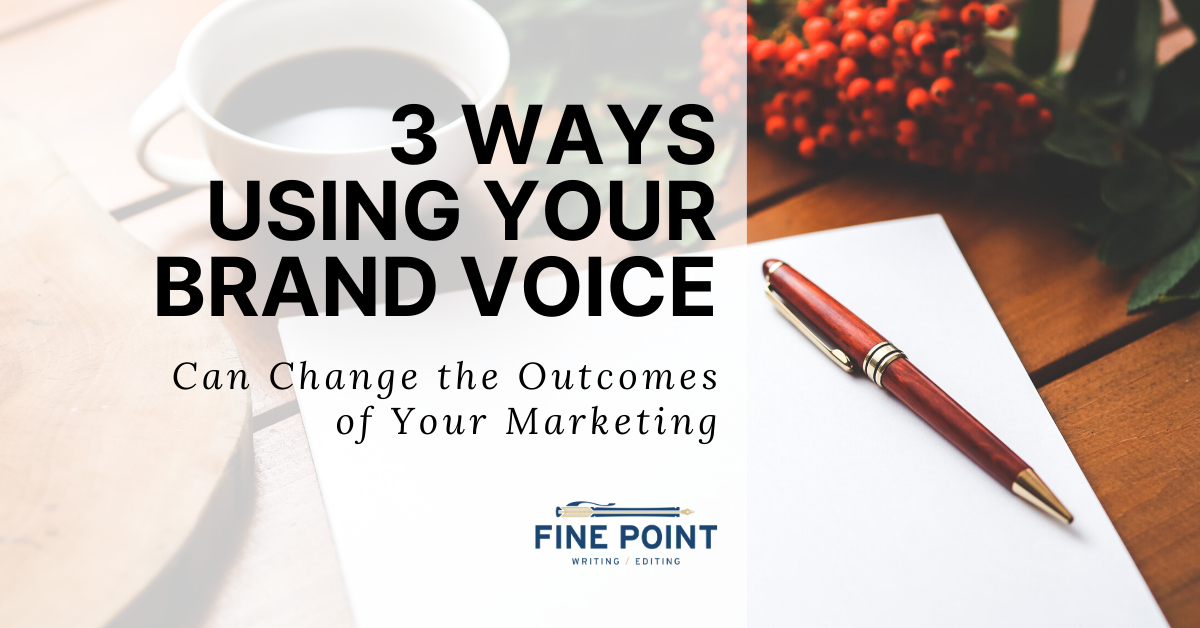Taking your marketing from bland to bold with a simple process.
3 Ways Using Your Brand Voice Can Change the Outcomes of Your Marketing
Writing can be a chore, but if there’s one thing that makes it less tedious, it’s making it feel more natural. When you relax into a voice that makes you feel confident and clear about your message, putting out a blog post or whipping up a caption for a social post is suddenly a lot less tedious.
In this blog post, I want to share how businesses can find and use their distinct brand voices. Not only will this make writing easier, but it will also help you connect more meaningfully with your customers. If you get it right, you can even create dedicated fans and followers for your brand!

What is a Brand Voice?
Your brand voice is how you deliver your content, written and otherwise.
We’ve all heard the proverb, “it’s not what you say; it’s how you say it.” When it comes to writing, this is doubly true because it’s more difficult to insert voice and tone into a written message. Without subtle cues like body language, facial expression, and inflections, we’re only left with the words we choose and how we arrange them.
The Difference Between Voice & Tone
Voice and tone are separate characteristics that describe the way a message is conveyed. You can think of voice as the personality behind the message. Who is speaking, and how do his or her personal characteristics shine through?
Meanwhile, tone is more situational. Think about how you talk to your boss versus how you talk to an old friend. Your voice might remain mostly the same, but your tone will shift depending on whether you’re at a funeral or a party, talking to a group or a single person, or arguing a point versus comforting a friend.
It can be easy for people to mistake the tone of a message when they’re reading text. Imagine you just sent a lengthy and emotional text message to someone and getting back an abrupt “sure.” She was probably distracted or in a rush, so she was thinking about convenience, not the voice and tone of the reply. And while that’s not a terrible offence in a personal text message when there’s a chance to explain the situation later, marketing messaging can’t overlook the importance of tone.

Unfortunately, there isn’t a lot of room here to talk about tone. But keep it in mind as we focus on the personality-building behind brand voices.
What Does a Brand Voice Do for Your Brand?
Who would you hire as a voice-over artist for a promotional video? Someone with the profound and serious tone of Morgan Freeman? Or the relaxing voice of someone who leads meditation classes? Maybe someone who can GET THE PARTY STARTED!
If you think this is a question that matters, then you already understand the importance of voice to some extent.
First, voice is tied to emotion. And there’s nothing like emotion to motivate people to take action. If you want someone to get excited enough to do something they might not have otherwise done, you’re probably not going to choose a slow and droning voice to convince them to do it.

Voice is about emotion, but it’s also a basic component of the connection between people. You might think that sounds strange; why would a brand need to stimulate a sense of human connection? After all, it’s a business, not a person. We’re here to sell products, not relationships, right?
Wrong!
All marketing is about communication, and communication is about people, not things. The object at the center of a conversation is important, sure. But an object can be described in thousands of subjective ways, so much so that the object itself is transformed by the way it’s described. You could talk about a dress as “designer-made with a pleated skirt,” or you could describe it as “Marilyn Monroe’s classic white cocktail dress with a modern flair.”
And sure, it’s possible to sell a product without any personality. But it’s not possible to sell a brand without one. A brand is meant to be personalized. It needs to inspire action, feelings, and a sense of connection. Otherwise, it’s just another object (and objects are easily replaced by other objects).
Giving Your Brand a Personality; Giving Your Brand a Voice
Voice comes from personality. That’s not to say that voice is necessarily intentional, though. For most brands, the personality is already there, so it’s just about defining that personality and figuring out how to create a distinct voice from that definition.
When I create brand voice guides, I help guide brands toward the characteristics that will help them connect with their ideal audience. For example, a fitness brand aimed at helping people who don’t see themselves as “fit” might be a little cheeky, allowing them to help their customers break down walls and feel more comfortable and less self-conscious. Meanwhile, a brand that’s designed for moms who are short on time might be more down to earth, using plain language and straightforward examples.
With that being said, here are the steps you can follow to set up a brand voice guide (of course, you can always get in touch if you want a professional hand in the process!)
- Create your ideal customer avatar (and get specific!)
- Figure out what your audience needs from you. Why do you click with a certain type of person?
- Choose the brand characteristics that represent the relationship between you and your ideal customer. Are you stylish? Warm? Logical? Eccentric? Is that what your customer needs you to be?
- Figure out how your characteristics can actually shine through in your content. A brand voice guide should tell everyone involved in your brand how to communicate. Email signatures are a great example. Do you sign off with “sincerely,” “thanks,” “kind regards,” or, “cheers?” The word you choose says a lot about your brand!
The Brand Voice Challenge
This week, I challenge you to read back over a blog post, email, or website page that you’ve written in the past. Look at specific word choices and see how they impact the voice and tone of your message. Are they in line with what your customers need from you? Do they represent that relationship? If not, play around with changes, saving your two different drafts so you can compare them.
And of course, if you need support, get in touch! Fine Point Writing & Editing has a fun and interactive brand voice guide process to get you and your team on the same page. Or, if you want to really dive deeper into branding, you can sign up for the Brand Mastermind workshop with myself and a designer I work closely with at Paper Lime Creative. Head to the branding page on the Fine Point Writing & Editing website to learn more.






